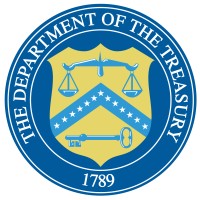
U.S. Department of the Treasury Company Cyber Security Posture
treasury.govThe Treasury Department is the executive agency responsible for promoting economic prosperity and ensuring the financial security of the United States. The Department is responsible for a wide range of activities such as advising the President on economic and financial issues, encouraging sustainable economic growth, and fostering improved governance in financial institutions. The Department of the Treasury operates and maintains systems that are critical to the nation's financial infrastructure, such as the production of coin and currency, the disbursement of payments to the American public, revenue collection, and the borrowing of funds necessary to run the federal government. The Department works with other federal agencies, foreign governments, and international financial institutions to encourage global economic growth, raise standards of living, and to the extent possible, predict and prevent economic and financial crises. The Treasury Department also performs a critical and far-reaching role in enhancing national security by implementing economic sanctions against foreign threats to the U.S., identifying and targeting the financial support networks of national security threats, and improving the safeguards of our financial systems.
UDT Company Details
us-treasury
14498 employees
150246.0
922
Government Administration
treasury.gov
Scan still pending
U.S_1802045
In-progress
Between 900 and 1000
This score is AI-generated and less favored by cyber insurers, who prefer the TPRM score.
 UDT Global Score
UDT Global Score.png)

U.S. Department of the Treasury Company Scoring based on AI Models
| Model Name | Date | Description | Current Score Difference | Score |
|---|---|---|---|---|
| AVERAGE-Industry | 03-12-2025 | This score represents the average cybersecurity rating of companies already scanned within the same industry. It provides a benchmark to compare an individual company's security posture against its industry peers. | N/A | Between 900 and 1000 |
U.S. Department of the Treasury Company Cyber Security News & History
| Entity | Type | Severity | Impact | Seen | Url ID | Details | View |
|---|---|---|---|---|---|---|---|
| US Treasury Department | Breach | 100 | 5 | 12/2024 | US-000010125 | Link | |
Rankiteo Explanation : Attack threatening the organization’s existenceDescription: A breach in early December 2024 at the US Treasury Department involved remote access by hackers to Treasury computers, compromising certain unclassified documents. By exploiting vulnerabilities in remote support software from BeyondTrust, identified as CVE-2024-12356 and CVE-2024-12686, attackers stole an authentication key, enabling system access. Despite the breach being attributed to a Chinese state-sponsored APT actor, no ongoing access was found. The incident sparked collaborations with FBI, CISA, and intelligence agencies for a comprehensive evaluation. | |||||||
| United States Treasury Department | Breach | 100 | 5 | 1/2025 | US-000010525 | Link | |
Rankiteo Explanation : Attack threatening the organization’s existenceDescription: An Advanced Persistent Threat group, suspected to be linked to the Chinese government, exploited vulnerabilities in BeyondTrust's software, resulting in a major breach of the Treasury Department. Authentication key theft allowed access to department computers with 'certain unclassified documents' compromised. The impact of this breach sees confidential governmental operations exposed, though classified as unclassified, could endanger financial stability or lead to further undisclosed consequences. | |||||||
| US Treasury | Breach | 100 | 5 | 12/2024 | US-000010925 | Link | |
Rankiteo Explanation : Attack threatening the organization’s existenceDescription: The US Treasury Department experienced a security breach where attackers exploited vulnerabilities in BeyondTrust's remote tech support software, leading to unauthorized access to Treasury computers and certain unclassified documents. Attackers stole an authentication key, compromising unclassified data. The incident was linked to a China state-sponsored APT actor. While the compromised service was taken offline, the breach was classified as a major cybersecurity incident, prompting collaboration with the FBI, CISA, and the intelligence community for investigation. | |||||||
| United States Treasury | Breach | 100 | 5 | 1/2025 | US-000011025 | Link | |
Rankiteo Explanation : Attack threatening the organization’s existenceDescription: The United States Treasury suffered a 'major' breach when an Advanced Persistent Threat group, believed to be linked to the Chinese government, exploited flaws in BeyondTrust software. The attackers stole an authentication key, gaining access to department computers and managing to steal 'certain unclassified documents'. While classified as unclassified, the breach's full extent and subsequent risks, such as exposure to financial manipulations and international diplomatic consequences, are still under assessment. | |||||||
| US Treasury | Breach | 100 | 5 | 3/2025 | US-000030825 | Link | |
Rankiteo Explanation : Attack threatening the organization’s existenceDescription: The breach of the US Treasury by Chinese hackers, including 12 individuals indicted by the Department of Justice, resulted in significant data compromise. Over a three-month period, at least 400 PCs were infiltrated leading to the theft of more than 3,000 files. This attack highlights the risk posed by autonomous state-sponsored hacking groups who target and steal sensitive information from high-profile international entities, selling it to government clients for strategic advantages. | |||||||
| U.S. Department of the Treasury | Cyber Attack | 100 | 6 | 12/2022 | USD13361222 | Link | |
Rankiteo Explanation : Attack threatening the economy of a geographical regionDescription: Companies suffered as a result of hacking attacks against US federal entities, affected departments included the US Department of Homeland Security, the Department of Commerce, and the Department of the Treasury. Early this year, Iranian government-sponsored hackers, including the FBI and CISA, gained access to a network of an unnamed US federal agency and used the Log4Shell vulnerability to install crypto miners and use stolen passwords. According to the advisory, "Cyber threat actors advanced to the domain controller (DC), compromised credentials, implanted Ngrok reverse proxies on multiple hosts to maintain persistence, and then exploited the Log4Shell vulnerability in an unpatched VMware Horizon server to install XMRig crypto mining software. | |||||||
| US Treasury | Cyber Attack | 100 | 5 | 1/2025 | US-000012325 | Link | |
Rankiteo Explanation : Attack threatening the organization’s existenceDescription: The US Treasury experienced a significant cyberespionage campaign resulting in the penetration of at least 400 of its PCs and the theft of over 3,000 files. Though hackers targeted sanctions and law-enforcement related information, they did not obtain access to emails or classified network segments, nor was long-term access malware identified. The scope of intrusion by Chinese state-sponsored hackers, including efforts by Salt Typhoon, suggests a focus on espionage without immediate financial or personal data leak but potential long-term strategic implications. | |||||||
U.S. Department of the Treasury Company Subsidiaries

The Treasury Department is the executive agency responsible for promoting economic prosperity and ensuring the financial security of the United States. The Department is responsible for a wide range of activities such as advising the President on economic and financial issues, encouraging sustainable economic growth, and fostering improved governance in financial institutions. The Department of the Treasury operates and maintains systems that are critical to the nation's financial infrastructure, such as the production of coin and currency, the disbursement of payments to the American public, revenue collection, and the borrowing of funds necessary to run the federal government. The Department works with other federal agencies, foreign governments, and international financial institutions to encourage global economic growth, raise standards of living, and to the extent possible, predict and prevent economic and financial crises. The Treasury Department also performs a critical and far-reaching role in enhancing national security by implementing economic sanctions against foreign threats to the U.S., identifying and targeting the financial support networks of national security threats, and improving the safeguards of our financial systems.
Access Data Using Our API

Get company history
.png)
UDT Cyber Security News
A Trio of US Treasury Hacks Exposes a Pattern Making Banks Nervous
In three major hacks, Treasury didn't deploy cybersecurity measures that could have prevented the attacks or flagged the intruders sooner, ...
Treasury Department says state-linked hacker gained access to unclassified data in major attack
The U.S. Treasury Department said a state-sponsored hacker gained access to unclassified documents on Treasury Department workstations after ...
US Treasury says Chinese hackers stole documents in 'major incident'
Chinese state-sponsored hackers breached the Treasury Department's computer security guardrails this month, according to a letter to ...
Treasury Department hacked: Explaining how it happened
The cause of the incident is apparently tied to a vulnerable third-party software component used by the Treasury Department. The vulnerable ...
China-backed hackers breached the US Treasury Department. Here’s what we know.
Chinese government hackers breached the US Treasury Department. Among other things, the hackers breached the office that administers economic sanctions.
Banking Groups Urge US Treasury to Improve Security After Email Hack
(Bloomberg) -- Financial-sector trade groups are urging the US Treasury Department to bolster its cybersecurity in response to hackers ...
As DOGE teams plug into federal networks, cybersecurity risks could be huge, experts say
Little is known about how workers on Elon Musk's federal government technology team are accessing sensitive systems at the Office of ...
Treasury breached by Chinese hackers in 'major' cybersecurity incident
The Treasury Department was breached by a Chinese state-sponsored hacker in a “major” cybersecurity incident earlier this year, ...
‘Major incident’: China-backed hackers breached US Treasury workstations
The US Treasury Department notified lawmakers on Monday that a China state-sponsored actor infiltrated Treasury workstations in what officials ...

UDT Similar Companies

U.S. Department of Homeland Security
The Department of Homeland Security (DHS) has a vital mission: to secure the nation from the many threats we face. This requires the hard work of more than 260,000 employees in jobs that range from aviation and border security to emergency response, from cybersecurity analyst to chemical facility in

City of Toronto
The City of Toronto is committed to fostering a positive and progressive workplace culture, and strives to build a workforce that reflects the citizens it serves. We are committed to building a high performing public service, with strong and effective leaders to enable service excellence, through hi

Landeshauptstadt Hannover
Die Stadt Hannover entstand irgendwann im Mittelalter als kleine dörfliche Siedlung auf einer hochgelegenen und damit hochwasserfreien Terrasse der Leine (Honovere= das hohe Ufer). Nach dem 2. Weltkrieg erholte sich die Stadt schneller als man dachte. Auf den Trümmern wurde eine moderne Stadt er

Sécurité sociale
Système de protection universel auquel chacun contribue à la hauteur de ses moyens, la Sécurité sociale accompagne et protège nos concitoyens dans tous les moments de leur vie. La Sécurité sociale se compose de cinq grandes branches : - les Allocations familiales, aident la population française da

East Riding of Yorkshire Council
East Riding of Yorkshire Council is a unitary authority which means that all local council services are provided by the same council. This is different to other parts of the country where responsibility is shared between a county council and a local district or borough council. The East Riding is

I work for NSW
The NSW public sector includes ten departments and many agencies and organisations working together to develop policy and deliver important services such as health, education, housing, transport and infrastructure across NSW. We are over 300,000 dedicated people who share the same values - making a

Frequently Asked Questions
Explore insights on cybersecurity incidents, risk posture, and Rankiteo's assessments.
UDT CyberSecurity History Information
How many cyber incidents has UDT faced?
Total Incidents: According to Rankiteo, UDT has faced 7 incidents in the past.
What types of cybersecurity incidents have occurred at UDT?
Incident Types: The types of cybersecurity incidents that have occurred incidents .
Additional Questions
What Do We Measure?
















Every week, Rankiteo analyzes billions of signals to give organizations a sharper, faster view of emerging risks. With deeper, more actionable intelligence at their fingertips, security teams can outpace threat actors, respond instantly to Zero-Day attacks, and dramatically shrink their risk exposure window.
These are some of the factors we use to calculate the overall score:
Identify exposed access points, detect misconfigured SSL certificates, and uncover vulnerabilities across the network infrastructure.
Gain visibility into the software components used within an organization to detect vulnerabilities, manage risk, and ensure supply chain security.
Monitor and manage all IT assets and their configurations to ensure accurate, real-time visibility across the company's technology environment.
Leverage real-time insights on active threats, malware campaigns, and emerging vulnerabilities to proactively defend against evolving cyberattacks.




